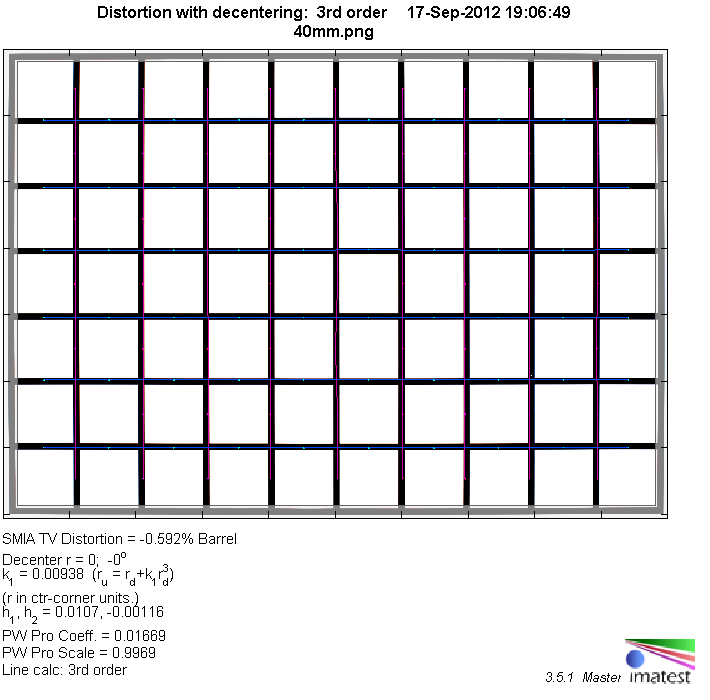|
Canon EF 40mm f/2.8 STM - APS-C Format Review / Test Report - Analysis |
|
Lens Reviews -
Canon EOS (APS-C)
|
|
Page 2 of 2

Distortion
The Canon pancake lens produces only a slight amount of barrel distortion (0.6%) which is basically negligible.

Vignetting
The EF 40mm f/2.8 STM is a full format lens so it has a natural advantage with respect to vignetting when being used on an APS-C DSLR. However, the lens does not excel here. The light falloff at large aperture is comparatively high at about 0.9EV (f-stops). This can be noticeable in certain scenes. However, the issue is basically gone from f/4 onward.

MTF (resolution)
Pancake lenses tend to be easy fellows - due to their comparatively slow speed their design is not overly complicated. Consequently we can report positive results from the MTF lab. The center resolution is already excellent at f/2.8 and even the borders & corners are easily very good. Stopping down to f/4 improves the performance a bit to an excellent quality across the image frame. Due to the usual diffraction effects the performance decreases at f/8 and, of course, more so at f/11. However, the quality is still usable here. There is a bit of field curvature.
The tested sample had a good centering quality.
Please note that the MTF results are not directly comparable across the different systems!
Below is a simplified summary of the formal findings. The chart shows line widths per picture height (LW/PH) which can be taken as a measure for sharpness.
If you want to know more about the MTF50 figures you may check out the corresponding Imatest Explanations
Chromatic Aberrations (CAs)
Lateral CAs (color shadows at the image borders) stay at or below an average pixel width of around 0.6px at the image borders. This is basically negligible.
 Note: The results are slightly worse here than in our full format test because the pixel density of the test camera is somewhat higher - the effect is therefore magnified a bit (albeit on a smaller image circle).
Note: The results are slightly worse here than in our full format test because the pixel density of the test camera is somewhat higher - the effect is therefore magnified a bit (albeit on a smaller image circle).
Bokeh
You may debate whether the bokeh (quality of the out-of-focus blur) plays a major role in a 40mm f/2.8 lens. After all you have to choose a rather short focus distance in order to achieve a decently shallow depth-of-field. However, Canon outlines this aspect as a strength of the lens so let's have a look at it.
The out-of-focus highlight rendition is pretty good - at least near the center. The shape of the highlight disc is pretty circular here and the inner zone is pretty smooth. However, there is a rather pronounced outlining effect at f/2.8. The outlining is gone once you stop down a bit.
 In our full format review we criticized the tendency of producing "cat's eye"-shaped highlights near the border region (at f/2.8). On APS-C cameras the critical region is MOSTLY outside of the smaller image field.
The quality of the general blur in the focus transition zone is decent. The foreground blur is a bit busy whereas the more critical background blur is smoother but still not perfect.
In our full format review we criticized the tendency of producing "cat's eye"-shaped highlights near the border region (at f/2.8). On APS-C cameras the critical region is MOSTLY outside of the smaller image field.
The quality of the general blur in the focus transition zone is decent. The foreground blur is a bit busy whereas the more critical background blur is smoother but still not perfect.

Bokeh Fringing / Longitudinal Chromatic Aberrations (LoCA)
The so-called bokeh fringing refers to colored halos in the focus transition zone. Hard contrasts can have a purple color tint in the foreground changing to greenish beyond the focus point. The EF 40mm f/2.8 STM shows a very slight bokeh fringing at f/2.8 but it's basically gone by f/4 already.
If you scroll through the sample crops below you may notice another effect though - there is a bit of a focus shift when stopping down (residual spherical aberration). The focus hot spot moves towards the background here.
|
Move the mouse cursor over the f-stop marks below to observe the respective LoCAs
|
| f/2.8 |
f/4 |
f/5.6 |
|

|
VerdictThe Canon EF 40mm f/2.8 STM represents a bit of a debatable concept on a DSLR - at least when compared to the much smaller mirrorless camera system. Honestly speaking there is also not really much of a size and weight advantage when thinking of its closest cousin - the Canon EF 50mm f/1.8 - which is also a faster lens. However, we wouldn't dare to state that it's not an attractive lens. It is just too cute for that. Other than that it has also several hard arguments on its side. The optical performance is certainly very impressive. This is especially true for the bitingly sharp center but even the border and corner quality is on a very high level straight from f/2.8. The low amount of lateral CAs contributes to the very high sharpness perception and the barrel distortion is nothing to worry about either. The lens produces a comparatively high amount of light falloff at max. aperture but stopping down to f/4 solves the issue. The quality of the bokeh is good but we wouldn't really call it a highlight. It's somewhat better on APS-C than on full format cameras though. Bokeh fringing is generally a non-issue. The EF 40mm f/2.8 STM suffers a bit from a focus shift when stopping down (residual spherical aberration). In very shallow depth-of-field situation (thus at close focus distances) this may be noticeable because DSLRs take AF readings at max. aperture only so the guidance for the other aperture settings can be very slightly off.
The build quality of the lens is on a very high level although we would have preferred to get a lens with a constant physical length across the focus range. We are slightly unsure what to think of Canon's new STM (stepping motor) AF. As of the time of this review the EOS 650D is the only available camera that has been optimized for the new AF motor. On older models the AF is certainly fast and also virtually silent but not really an improvement over the conventional USM (ultrasonic) AF. The AF tracking capabilities are sub-par although that's not really a primary use case here anyway.
The Canon EF 40mm f/2.8 STM is certainly a fine lens and if you can make sense of its focal length and max. aperture we can certainly recommend it highly!
|